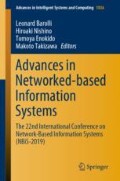Abstract
Wi-Fi based sensing becomes more and more popular in ubiquitous computing with prevalence of Wi-Fi devices. In this paper, we propose a new task, indoor trajectory sensing, based on Received Signal Strength Indicator (RSSI) of Wi-Fi. Traditional distance measure based methods, like Dynamic Time Warping (DTW) based Nearest-Neighbor (1NN) method, have poor performance in indoor trajectory sensing due to that RSSI of Wi-Fi in indoor environment is fluctuating, partially missing, time-varying and device-dependent. Recently, Recurrent Neural Networks (RNN) and its variants have strong abilities in learning the temporal dependency of sequence data since it can extract more meaningful features. Consequently, it is necessary to design an RNN model for the indoor trajectory sensing problem with relatively small size data. We adopt a passive way to collect Wi-Fi signals from the smart phone to ensure more data collected and generate multiple time series for each trajectory. For the recurrent neural network training, RNN and its variants are applied into our sequence data to find more meaningful patterns especially for different environment and devices. Series of real-world experiments have been conducted in our test bed and the results show that the deep based approach can achieve better performance than traditional methods with challenging environment and device factors.
Access this chapter
Tax calculation will be finalised at checkout
Purchases are for personal use only
References
Jeong, Y.-S., Jeong, M.K., Omitaomu, O.A.: Weighted dynamic time warping for time series classification. Pattern Recognit. 44(9), 2231–2240 (2011)
Wang, X., Mueen, A., Ding, H., Trajcevski, G., Scheuermann, P., Keogh, E.: Experimental comparison of representation methods and distance measures for time series data. Data Min. Knowl. Disc. 26(2), 275–309 (2013)
Chouakria-Douzal, A., Nagabhushan, P.N.: Improved fréchet distance for time series. In: Data Science and Classification, pp. 13–20. Springer, Berlin (2006)
Chuan-Chin, P., Chung, W.-Y.: Mitigation of multipath fading effects to improve indoor RSSI performance. IEEE Sens. J. 8(11), 1884–1886 (2008)
Zheng, V.W., Xiang, E.W., Yang, Q., Shen, D.: Transferring localization models over time. In: AAAI, pp. 1421–1426 (2008)
Li, H., Ng, J.K., Cheng, V.C.W., Cheung, W.K.: Fast indoor localization for exhibition venues with calibrating heterogeneous mobile devices. Internet of Things 3, 175–186 (2018)
LeCun, Y., Bengio, Y., Hinton, G.: Deep learning. Nature 521(7553), 436 (2015)
Wang, X., Gao, L., Mao, S., Pandey, S.: Deepfi: deep learning for indoor fingerprinting using channel state information. In: 2015 IEEE Wireless Communications and Networking Conference (WCNC), pp. 1666–1671. IEEE (2015)
Haseeb, M.A.A., Parasuraman, R.: Wisture: RNN-based learning of wireless signals for gesture recognition in unmodified smartphones. arXiv preprint arXiv:1707.08569 (2017)
Hu, W., Wang, Y., Song, L.: Sequence-type fingerprinting for indoor localization. In: International Conference on Indoor Positioning and Indoor Navigation (IPIN), Banff, Alberta, Canada (2015)
Ye, X., Wang, Y., Hu, W., Song, L., Gu, Z., Li, D.: Warpmap: accurate and efficient indoor location by dynamic warping in sequence-type radio-map. In: 2016 13th Annual IEEE International Conference on Sensing, Communication, and Networking (SECON), pp. 1–9. IEEE (2016)
Hochreiter, S., Schmidhuber, J.: LSTM can solve hard long time lag problems. In: Advances in Neural Information Processing Systems, pp. 473–479 (1997)
Cho, K., van Merriënboer, B., Gulcehre, C., Bahdanau, D., Bougares, F., Schwenk, H., Bengio, Y.: Learning phrase representations using rnn encoder-decoder for statistical machine translation. arXiv preprint arXiv:1406.1078 (2014)
Chung, J., Gulcehre, C., Cho, K., Bengio, Y.: Empirical evaluation of gated recurrent neural networks on sequence modeling. arXiv preprint arXiv:1412.3555 (2014)
Weiss, G., Goldberg, Y., Yahav, E.: On the practical computational power of finite precision rnns for language recognition. arXiv preprint arXiv:1805.04908 (2018)
Author information
Authors and Affiliations
Corresponding author
Editor information
Editors and Affiliations
Rights and permissions
Copyright information
© 2020 Springer Nature Switzerland AG
About this paper
Cite this paper
Li, H., Ng, J.K., Ke, J. (2020). Deep Recurrent Neural Networks for Wi-Fi Based Indoor Trajectory Sensing. In: Barolli, L., Nishino, H., Enokido, T., Takizawa, M. (eds) Advances in Networked-based Information Systems. NBiS - 2019 2019. Advances in Intelligent Systems and Computing, vol 1036. Springer, Cham. https://doi.org/10.1007/978-3-030-29029-0_41
Download citation
DOI: https://doi.org/10.1007/978-3-030-29029-0_41
Published:
Publisher Name: Springer, Cham
Print ISBN: 978-3-030-29028-3
Online ISBN: 978-3-030-29029-0
eBook Packages: Intelligent Technologies and RoboticsIntelligent Technologies and Robotics (R0)

